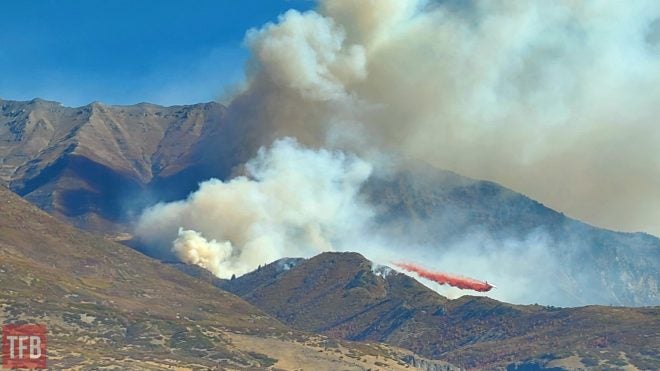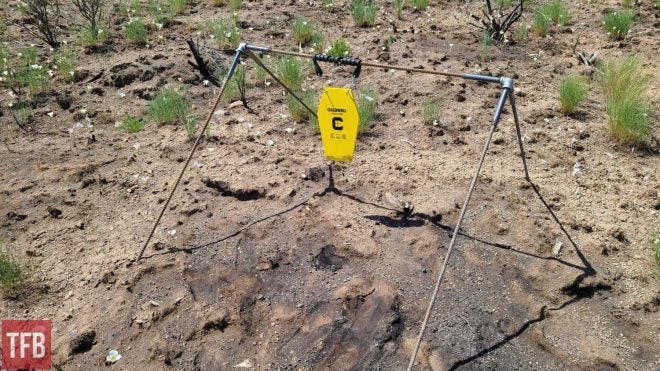
Wildfires have long been a feature of life in the western states. Unfortunately, target shooting starts some of those fires. The good news is that target shooting fires are preventable, so let’s discuss how we can keep them from happening. Public lands make for some of the best shooting spots, but they are at risk of closure every time a negligent shooter starts a wildfire.

A DC-10 firefighting aircraft working on the Range Fire in Orem, Utah in 2020
Two years ago, a major wildfire in my neck of the woods was started by target shooting at the local police shooting range. It was aptly named the Range Fire, and grew to approximately 3,500 acres. The fire originated in the “wildland-urban interface” where the city stops and public land begins, and assets from multiple states had to respond. This included massive DC-10 tankers, helicopters, and water-scooping planes. It was not cheap to put out this fire.
The Range Fire, along with several other gunfire-sparked wildfires, led the state of Utah to start a public outreach campaign. I came across a display at the local Sportsman’s Warehouse with a cardboard cutout of a firefighter, a burned tree, and what appeared to be free targets on a table.

“Target” informational flyer put out by the State of Utah
On closer inspection, the “targets” were actually informational flyers about fire mitigation steps that target shooters can take. Personally, I prefer informing the public so they can help prevent the problem rather than use overbroad controls like seasonal shooting closures. This seems like a low-cost, high-return effort if it prevents even a single wildfire.
Don’t Shoot Near Rocks or Dry Grass
The first two pieces of advice from the Utah flyer are certain types of backstops that should be avoided. Rocks make unwise targets because they can spark when hit depending on their composition. Ricochets can also lead to unpredictable fire starts in distant places. If those sparks land in dry grass, they can grow to become a flame. Avoiding both is the safest course of action.

Caldwell Targets AR-500 steel set up in a spot that burned the previous year, where there is nothing left to burn
Don’t Shoot Exploding Targets
Exploding targets have been linked to several wildfires, and their use is banned on many public lands. In one extreme example, a 47,000-acre fire was started in Arizona with an exploding gender reveal target. That fire resulted in a $220,000 fine and five years of probation for the Border Patrol agent who started the blaze. Explosions are cool, but.
Don’t Shoot on Hot and Windy Days
We have all heard the phrase “if it ain’t raining it ain’t training,” but rain also (obviously) reduces fire risk. What may be less obvious is that hot and windy days with low humidity increase wildfire risk. The National Weather Service issues warnings when weather conditions like these pose a high fire risk called “red flag warnings.” Shooting outdoors, especially outside of a controlled range, is more dangerous. High winds can fan a flame and spread a small fire into a large conflagration before it can be contained. As much as it sucks, sometimes the right call is canceling a range day rather than taking your chances.
Risky Ammo
The flyer did not talk about types of ammunition that are more likely to cause sparks. Some are very obvious and already banned on most public lands, such as tracers or incendiary ammo. These pose obvious fire risks because they are designed to burn.
Steel core ammunition is also a frequent culprit, such as M855 “green tip” 5.56x45mm. The steel penetrator acts like a flint and steel fire starter and can create a large shower of sparks. Bi-metal jacketed projectiles have copper plating over a steel jacket and produce similar results. Bi-metal jackets are frequently found in Russian steel-case ammunition, which will, unfortunately, be drying up on the U.S. market. If in doubt, put a magnet on the projectile and see if it sticks. If so, it is unwise to use it when wildfire risk is high.

(L to R) 5.45x39mm with bimetal jacket, 5.45x39mm with steel core, 5.56x45mm with steel core
Studies have also shown that solid copper projectiles also tend to start fires at a higher rate than common lead core, copper jacketed bullets. However, all bullets are extremely hot when fired and can ignite a fire in the right circumstances.
Being Prepared
The flyer did not talk about extinguishing fires you may start, but that type of mitigation is also worthwhile. I generally take a shovel and plenty of water along with me in the dry months. A fire extinguisher is not a bad idea either (one saved me from starting a huge fire, but that is a story for another day). Obviously, do not put your life at risk to put out a fire you may have started. But a gallon of water or a few shovelfuls of dirt might be enough to put out some smoldering grass.
Conclusion
Don’t be that guy who starts a big wildfire. They put lives and homes at risk, cost millions of dollars to contain, and can lead to permanent shooting closures. Be smart about what you are shooting, where you are shooting, and when you are shooting.